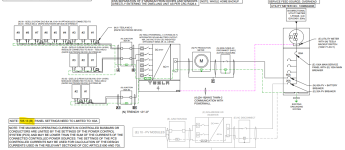hitehm
Senior Member
- Location
- Las Vegas NV
All - Please see the attached SLD of the backfed PW3 system we're installing with an existing 20A backfed unmonitored system and refer to 705.12 and 702.13 for this discussion. Our issue is as follows: The engineering team is setting the PW3 Panel Limit feeding the 100A main panel bus to 60A. They limited the max monitored and controlled pcs sources (the pw3 and solar) to 80% of the bus rating. This is based on Tesla's own doc that states (in so many words) you must consider the bus to be 80% of its rating because of the way manufacturers test their equipment. That's fine, so that would make the max PCS output 80A. However, they are also subtracting the 20A unmonitored existing system from the PCS making the max PCS panel limit 60A. Although this seems logical in several ways, we can find absolutely no code or AHJ rule that says to do this. In all of 705.13 the only language that deals with unmonitored sources on the busbar is 705.13A that states:
705.13A Any busbar or conductor on the load side of the service disconnecting means that is not monitored by the PCS shall comply with 705.12
There is no mention of subtracting this value from the monitored controlled source. The engineering team highlight 705.13B as their reasoning but it vaguely at best only states the PCS can be no more than the OCP it's connected to if connected to an unmonitored bus. Tesla considers this bus monitored if it has CTs on the utility consumption input to the bus and of course its own output feeding the bus.
705.13B - Where the PCS is connected to an overcurrent device protecting any busbar or conductor not monitored by the PCS, the setting of the PCS controller shall be set within the ratings of that overcurrent device.
Therefore, we believe by the CODE, the PCS Panel Limit setting should be 80A not 60A and let the unmonitored existing system follow the 120% rule of 705.12. But this brings up the obvious problem that the existing system can still apply 20A in addition to the 80A pcs from the PW3 which combined is more than 80% of the bus rating. Also, without monitoring the existing system, even though you are monitoring the main bus source inputs from both the utility and the PW3, is the bus FULLY monitored if you don't monitor ALL the other source on that bus?
So the question for all is, how is this interpreted correctly and should the unmonitored source be subtracted from the PW3 panel limit?

705.13A Any busbar or conductor on the load side of the service disconnecting means that is not monitored by the PCS shall comply with 705.12
There is no mention of subtracting this value from the monitored controlled source. The engineering team highlight 705.13B as their reasoning but it vaguely at best only states the PCS can be no more than the OCP it's connected to if connected to an unmonitored bus. Tesla considers this bus monitored if it has CTs on the utility consumption input to the bus and of course its own output feeding the bus.
705.13B - Where the PCS is connected to an overcurrent device protecting any busbar or conductor not monitored by the PCS, the setting of the PCS controller shall be set within the ratings of that overcurrent device.
Therefore, we believe by the CODE, the PCS Panel Limit setting should be 80A not 60A and let the unmonitored existing system follow the 120% rule of 705.12. But this brings up the obvious problem that the existing system can still apply 20A in addition to the 80A pcs from the PW3 which combined is more than 80% of the bus rating. Also, without monitoring the existing system, even though you are monitoring the main bus source inputs from both the utility and the PW3, is the bus FULLY monitored if you don't monitor ALL the other source on that bus?
So the question for all is, how is this interpreted correctly and should the unmonitored source be subtracted from the PW3 panel limit?




